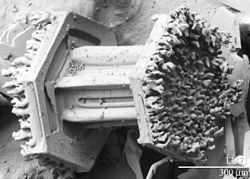Rime ice
This article needs additional citations for verification. (January 2025) |


Rime ice forms when
- Soft rime forms when supercooled water freezes under calm wind conditions. It is milky and crystalline, like sugar, and similar to
- Hard rime forms by rapid freezing of supercooled water under at least moderate wind conditions. The droplets freeze more or less individually, leaving air gaps.[4][3]
- Clear ice forms by slow freezing of supercooled water. Clear ice is typically transparent and homogeneous. Its amorphous and dense structure makes it adhesive.
Soft and hard rime are less dense than clear ice and less adhesive, thus generally cause less damage.
Rime ice also forms when
Hard rime

Hard rime is a white ice that forms when the water droplets in
Characteristics
Hard rime formations are more difficult to remove. They have a comb-like appearance, with the streaks of material parallel to that of the direction of the wind. This is unlike
Scientists at meteorologically extreme places, such as
Formation on snow crystals

Under some specific atmospheric conditions, forming and descending
The frozen droplets on the surface of rimed crystals are hard to resolve and the topography of a graupel particle is not easy to record with a visible-wavelength microscope because of the limited resolution and depth of field in the instrument. However, observations of snow crystals with a low-temperature scanning electron microscope (LT-SEM) clearly show cloud droplets measuring up to 50 μm on the surface of the crystals. The rime has been observed on all four basic forms of snow crystals, including plates, dendrites, columns and needles. As the riming process continues the mass of frozen, accumulated cloud droplets obscures the identity of the original snow crystal, giving rise to a graupel particle.[7]
Soft rime


Soft rime is a white ice deposition that forms when the water droplets in light freezing fog or mist freeze to the outer surfaces of objects during calm or light wind. The fog usually freezes to the
Soft rime is similar in appearance to
Soft rime formations appear as narrow white icy needles and scales. These needles are fragile and can be easily shaken off objects and removed. Factors that favour soft rime include: small drop size, the slow accretion of liquid water, a high degree of supercooling, and fast dissipation of latent heat of fusion. The opposite of these conditions favour ice with higher densities, such as the aforementioned
See also
References
- ^ WMO. "Rime". International Cloud Atlas. Retrieved 2025-02-25.
- ^ "What is Soft Rime?". Earth.com. Retrieved 2025-02-25.
- ^ a b L, Machelle (2018-03-15). "What Is Hard Rime and Soft Rime?". WeatherEgg®. Retrieved 2025-02-25.
- ^ "What is Hard Rime?". Earth.com. Retrieved 2025-02-25.
- ^ "Icing Hazards". www.weather.gov. Retrieved 2025-02-25.
- ^ WMO. "Hard Rime". International Cloud Atlas. Retrieved 2025-02-25.
- ^ a b Rime and Graupel, Electron Microscopy Unit, Beltsville Agricultural Research Center, U.S. Department of Agriculture., archived from the original on 1 May 2012, retrieved 25 August 2012
External links
- Hard Rime in Glossary, American Meteorological Society
- Soft Rime in Glossary, American Meteorological Society
- Weather Facts, WeatherOnline
![]() This article incorporates
This article incorporates
